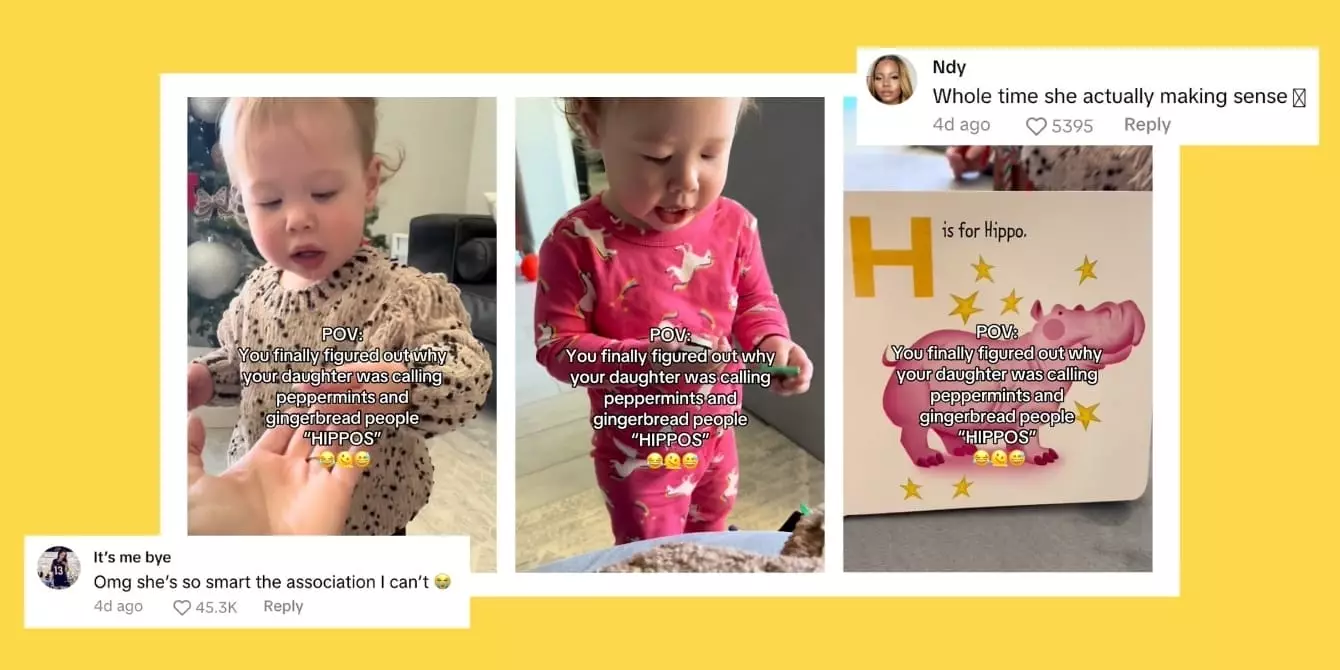The enchanting way toddlers interpret their surroundings sparks delight and sometimes bemusement among parents. With their imaginative phrases and unexpected associations, children at this age contribute an element of whimsy to everyday language. For instance, when a toddler dubs a peppermint candy as a “hippo” or calls a staple snack like Rice Krispie treats “raspberry Christmas trees,” it invites laughter and reflects their unique cognitive development. One recent video shared by a mother named Victoria captured this delightful confusion when her 16-month-old daughter excitedly labeled a peppermint after spotting it in an ABC book. Initially puzzled, Victoria uncovered the child’s line of reasoning; the peppermint was illustrated adjacent to gingerbread, illuminating the remarkable abstract thinking capacities of toddlers. This phenomenon calls for a deeper examination of what occupies their developing minds and how their language skills unfold.
The imaginative world through which toddlers perceive reality is fascinating, characterized by their reliance on context to make sense of what they see. At just 16 months, toddlers are busy building associations as their understanding of the world begins to flourish. The charming errors they make with words can initially appear nonsensical, yet they are grounded in solid reasoning from the child’s perspective.
Children often use cognitive associations to draw parallels and make sense of their experiences. For example, when Victoria’s toddler referred to a peppermint as a “hippo,” it was a creative leap that intertwined her visual exploration with the alphabet. This also explains why she might label all furry animals as “dog” or conceive the moon as merely a “light.” Their language reflects a blend of observation, emotional relevance, and auditory simplicity that is fundamental to this stage of development.
The emotions and sensory experiences accompanying words have a marked influence on toddlers’ vocabulary. This can be seen in the case of another mother whose child called airplanes “bees” due to the buzzing sound they produce. Such instances illustrate that toddlers often associate words with feelings or sounds that resonate with their experiences. A cake, linked with festive joy, might be lovingly described as “happy” for similar reasons.
This impressive ability to make connections sets the groundwork for vocabulary development and communication skills. Children are not merely stringing words together; they are forming emotional links that enhance their understanding and expression of the world around them.
Supporting Language Development Through Interaction
Recognizing how toddlers perceive and articulate their world can equip parents in nurturing their child’s language development. When a mix-up occurs, instead of simply correcting them, caregivers can engage in a dialogue that reveals the child’s thought process. Ask gentle questions that prompt reflection, such as “What does that remind you of?” or “Where have you seen this before?” This encourages the child to express their reasoning while also aiding the parent in understanding how their child connects ideas and words.
Moreover, celebrating these unique associations fosters an environment where curiosity thrives. Instead of discouraging their whimsical utterances, parents should encourage these creative expressions, revealing both the child’s intelligence and the joys of growing up.
The Importance of Shared Reading in Vocabulary Expansion
Reading together is a crucial component in fostering language development. Emphasizing emotional connections during storytime can significantly bolster both vocabulary and empathy. By discussing the feelings of characters and drawing connections between words and images, caregivers can enrich a child’s emotional and cognitive understanding.
Research supports the notion that engaging in meaningful discussions during reading contributes to better social skills and encourages sharing. Pointing to pictures and articulating names in books strengthens links between spoken words and their meanings, helping toddlers navigate language more effectively.
To help toddlers flourish in their language skills, parents can adopt a hands-on approach to engagement. This includes choosing books with straightforward illustrations and simple narratives while pointing out objects and naming them during reading sessions—an effective way to reinforce comprehension.
Furthermore, creating a supportive atmosphere that values creativity allows children to explore language without fear. Modeling patience, caregivers can enthusiastically accept unconventional names and provide gentle corrections—thus fostering a love for language.
These lighthearted moments in which toddlers mislabel objects are more than just moments of comic relief; they reflect the intricate processes behind early language development. While their charming errors often prompt amused reactions from parents, they also underline the deep connections toddlers form with their emerging vocabulary. Encouraging this playful exploration of language invites a sense of wonder that enriches both the child’s world and the parent-child bond.
As we witness the delightful antics of our little ones, let us celebrate their journeys into language—what lilting phrases will they surprise us with next? Capturing these memories might perhaps be the best way to cherish the joyful art of toddler expression.

